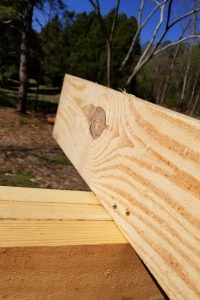Rafter Bearing and Anchorage
Rafter Bearing and Anchorage …
So, of course, the rafters need to `bear’ on (be supported by) something. For Linda’s Goat Barn the rafters will rest on `headers’. The design of the barn, remember, is `pole barn’, e.g., rafters supported by headers supported by posts that act as `poles’. The poles embedded in the ground provide the lateral stability (keep the barn from flopping over)1. In terms of construction, I want three things of the support conditions: 1) I need enough `length of contact’ so that the end of the rafter doesn’t `accidentally’ slide off the header; 2) I need some `anchorage’ to make sure the rafter doesn’t slide or get pulled off the header … during construction and afterward; and, 3) I need enough contact area (rafter on header), so that the wood isn’t crushed. I like to start with at least 1-1/2 inches `bearing length’2 … which generally keeps the rafter from sliding or falling off the support, and keeps the wood from crushing..

One and one-half inches `seems’ to provide enough length in most cases to keep the rafter (joist, beam, whatever) from accidentally sliding off the support during construction. Then to make sure it doesn’t slide off, we `anchor’ the rafter with, say, some nails. A typical code requirement for anchoring a rafter to a wall is … (3) 10d common nails in toenail (slant) configuration (two on one side and one on the other). Each end of rafter. Yup! That will anchor the ends of the rafter. Note that at this stage I’m not really worried about wind. If a wind comes along, construction stops, and I wait till it’s over. Besides, without the roofing material on yet, there’s not much to `catch sail’. Once I’m done with construction, I also need to make sure that the rafters don’t get pulled off the supports/headers if a wind comes along. For Linda’s Barn, I will `assume’ that the toenails used for anchorage also provide the necessary resistance to wind uplift3. For buildings occupied by humans, a tie-down design would be required, likely resulting in `hurricane ties’ being required to hold the rafters to the walls.
This idea of `sliding off’ is even more important with sloped rafters. Linda’s Barn’s roof is `1 in 12’ … not too steep, but not flat, either. I’ll definitely anchor the ends of the rafters before I `get up on them.’
Let’s see if we crush the wood … in this case the construction worker is not out there at mid-span … but closer to one end, so that nearly the whole weight of the worker goes through one end … 300 lb … a bit more if we count the added weight of the roof. Using 300 lb … and a (true) 2-inch wide rafter, bearing on at least 1.5 inch of header …
300 lb (man) divided by 2 inch (wide rafter) x 1.5 inch (length along header)… equals 300 lb / 3 square inches = 100 psi … any decent available wood should be able to carry 500 psi or more in bearing … Good!
Does this mean we could use less than 1.5 inches of bearing? NO!
________________
1As construction continues, the boards on the sides will also provide lateral support … kind of like `shear walls’ … relieving the posts, acting like vertical cantilever columns. from providing all the lateral support.
2Minimum of 1.5 inches bearing length Code references … (see, e.g., 2018 IBC 2308.7.3.1).
3Let’s do a quick calc … 100 mph wind … say 25 psf wind uplift (roof acting like an airfoil) … each end of rafter holds down (½ of 12 ft + 1 ft eave times 2 feet per rafter … 14 square foot of roof for each rafter end… 14 square feet times 25 pounds per square foot … gives … 350 pounds! I can probably get that with (3) 10d common toe nails. I’m actually going to use 8d and some 16d sinkers. I can probably get 100 pounds each out of the 8-d nails … that would correspond to, say, 90 mph wind. Fine. I haven’t accounted for the weight of the roof itself (though relatively light) in helping to hold the roof down. TBH, if we get a 100 mph wind, it will probably be accompanying a tornado, and I suspect the whole barn will be gone, with the cows, if still alive, standing in the rain, and the goats, if still alive, hiding under anything they can find to get out of the rain.